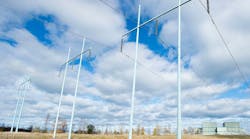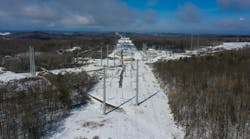In 2005, Transpower New Zealand, the transmission system operator and owner of the New Zealand national grid, was faced with the need to expand a site-restricted 220-kV substation while improving access and reducing cost. The design had to meet several requirements:
-
Improve maintenance access to installed equipment
-
Reduce the site's visual impact
-
Use standard air-insulated switchgear (AIS) transmission line and substation hardware
-
Comply with seismic and electrical clearance design standards
-
Reduce construction and maintenance costs
-
Lower the risk of failure
-
Reduce type and number of components and hardware.
In addition to complying with the transmission system operator's (TSO's) design standards for electrical, mechanical and environmental parameters, detailed consideration was given to alternative switchyard bus bar configurations. This has resulted in the development, testing and approval of a bus bar configuration that satisfies all the design criteria while offering improved access to equipment and a reduction in costs.
Existing Design Standards
Traditionally, Transpower would use one of two 220-kV bus bar configurations. First is the rigid-rigid configuration. In this configuration, a rigid main bus is above and at a right angle to a rigid transverse bus. The buses are comprised of tubular aluminum bus bars supported by post insulators on individual steel posts with concrete-pad foundations. Jumpers of flexible stranded conductors with compression fittings are used for the bolted connections between the bus sections and from the bus sections to the switchgear. Second is the rigid-flexible configuration. This configuration is similar to the first configuration with its rigid main bus except it uses stranded aluminum conductors supported on ground-mounted post insulators instead of a rigid transverse bus bar.
New Bus Bar Design
To improve access and reduce costs, Transpower opted to remove the steel posts supporting the flexible transverse bus sections, leaving the conductor to be supported by phase-to-phase insulators suspended from the main bus bar.
Although this new rigid-flexible design with suspended phase-to-phase insulation satisfied all the design criteria, Transpower had to conduct further detailed design checks to ensure all short-circuit and seismic forces could be accommodated. Due to time pressure on the original project, this work could not be completed so a separate project was established.
Research and development undertaken by Transpower and its engineering partner Electropar, a subsidiary of Preformed Line Products, subsequently revealed no similar bus designs were commonly used at transmission voltages. The determination was that, with suitable selection of components, it should be successful.
Component Selection
To reduce the need for specialized components and hardware, and to minimize costs, a 200-mm (7.9-inch)-diameter, 6-mm (0.24-inch)-wall-thickness standard tubular main bus was selected with current and fault ratings of 4,500 A and 200 kA per 3 sec, respectively.
Based on a unit cost of NZ$150/m (US$105/m), the tubular bus was 50% more expensive than the normal 140-mm (5.5-inch) bus at NZ$100/m (US$70 m). However, as the length of the bus bar required was considerably reduced, this design feature produced a savings of approximately 30%.
The acceptable current and fault ratings of an all-aluminum conductor are the main reasons Transpower selected this conductor for the transverse bus. The conductor has a fault rating of 36.2 kA per 3 sec, and normal and emergency current ratings of 1,290 A and 1,550 A, respectively.
Conductor Deflection
The static deflection of the 200-mm main bus was 31 mm (1.2 inches) before the insulators were added. The 400-kV composite insulators, complete with grading rings, each weigh approximately 46 kg (101 lb). This increased the mid-span deflection over a 13-m (43-ft) span to some 60 mm (2.4 inches), a value comparable to the existing design standards. The proposed use of the stranded-conductor transverse bus suspended from the main bus by composite insulators was checked to ensure the phase-to-phase and phase-to-earth clearances during a short circuit would not be compromised.
A Business Case
A multi-staged business case considering the advantages and disadvantages, cost and benefits was undertaken to justify further investment in the detailed design and testing required to turn the concept of the new bus bar configuration into reality.
The three disadvantages identified were the perceived risk in using phase-to-phase insulation within substations and on bus bars; the replacement of composite insulators up to 25 years earlier than ceramic insulators; and the use of a heavier main bus and supports.
The greatest safety hazard was the increase in the perceived risk of a bus bar fault due to failure of the phase-to-phase insulation. However, as bus bar protection schemes quickly remove a fault, the risk was considered less onerous than a close-in transmission line fault fitted with auto-reclose equipment.
There are several significant advantages of adopting phase-to-phase insulation:
-
Reduction in site footprint by 15% to 25%
-
Use of standard substation and transmission line components
-
No compromise of industry's standards on clearances and equipment spacing
-
Improved access for maintenance due to fewer constructions
-
Reduction in the visual impact through fewer structures
-
Improvement in system reliability and maintenance through reduction in the number of components
-
Reduction in construction times and substation cost.
Cost Comparison
The new design incorporates larger main bus bars and supporting structures, but the increased cost is more than offset by the savings accrued from the reduction in structures, foundations, insulators and ancillary fittings as well as the reduced civil, mechanical and electrical site labor costs.
Conservative estimates of the savings attributable to the use of the proposed design base indicate a savings of approximately NZ$30,000 (US$21,000) per switchgear bay. This savings is likely to be closer to NZ$100,000 (US$70,00) if the reduced site area savings, such as land purchased, civil works and cabling, are taken into consideration.
In early 2008, having successfully presented the commercial and operational case, approval was granted to proceed with the first stage of the design and testing program.
Design and Testing Program
The new design known as the high-voltage under-hung bus bar system (HVUBS) comprised standard Transpower and Electropar components, including the bus work, clamps, fittings insulators, structures and foundations. As a new design, it was vitally important to ensure the electrical and mechanical properties were adequate. Electropar subcontracted design consultant Beca to undertake the static analysis of each component to ensure the HVUBS met all service conditions, such as short-circuit, seismic, wind and snow load events.
On completion of this analysis, Beca arranged a third-party review of the results using AECOM and TransGrid, the TSO for New South Wales, Australia, to validate the design concept. The full-scale testing program had two main objectives:
-
To ensure the structural integrity of the components, especially the composite phase-to-phase insulator
-
To confirm the electrical performance and safety clearances were not compromised.
The global availability of commercial high current test laboratories able to fulfill the fault current tests and accommodate a 15-m by 15-m by 10-m (49-ft by 49-ft by 33-ft) test rig was very limited. In June 2009, the Powertech Laboratory in Canada was selected for testing and it arranged for local contractor Mott Electric to construct standard Transpower foundations, and erect the support structures and bus work at the test laboratory.
The combined Electropar-Transpower-Mott Electric team was responsible for installing the HVUBS in the laboratory. Then Powertech was able to complete the comprehensive test program during a period of five days with fault levels up to 63 kA. The data analysis confirmed the proposed design was feasible and none of the structural or electrical design limits were exceeded.
The HVUBS has been deployed at a new 220-kV breaker and a half station, Drury, near Auckland and is presently being installed at another new 220-kV station, Pakuranga. Drury has been in service for almost a year, with the benefits of the new system accruing as expected. The most favorable benefit being the additional openness and space it affords within the switchyard for maintenance. The system also is designed to be installed at 110 kV at a new switching station that makes use of disconnecting circuit breakers as another step to remove equipment and reduce cost while improving access and safety. The redevelopment of the existing 110-kV Karapiro Substation will be the first brownfield installation where the HVUBS will enable older sites to achieve the same increased safety and maintenance distances of new sites while removing legacy equipment and design constraints.
The design, development, testing and in-service deployment of the HVUBS has shown it does not compromise either phase-to-phase or phase-to-earth clearances, it meets all the load cases, and it delivers net financial, safety, maintenance and environmental benefits.
Ready for Use
Transpower gained a significant amount of intellectual property and knowledge about the process and system, and is happy to share this with other TSOs. Although the use of phase-to-phase insulation is not new, this particular application relied on a combination of modern materials and analysis tools, with the ultimate success of the project due, in no small part, to the dedicated efforts of a team assembled from across the globe.
Andrew Renton ([email protected]) is a qualified electrical engineer with more than 24 years experience working for transmission and distribution utilities and government agencies in New Zealand and Australia. Presently, Renton manages a team of substation, overhead line and cable professionals as Transpower's asset development engineering manager.
Bus Bar Design Standards
Companies mentioned:
AECOM | www.aecom.com
Beca | www.beca
Electropar | www.electropar.co.nz
Mott Electric | www.mottelectric.com
Powertech Laboratory | www.powertechlabs.com
Preformed Line Products | www.preformed.com
TransGrid | www.transgrid.com.au
Transpower | www.transpower.co.nz

